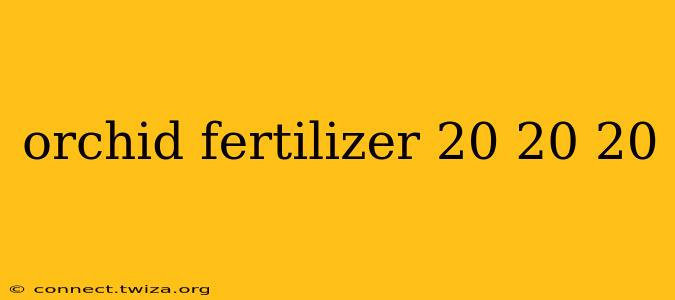Orchids, with their exquisite blooms and diverse varieties, are prized by plant enthusiasts worldwide. However, these beautiful plants have specific nutritional needs that require careful attention. One common question revolves around fertilizer, particularly the popular 20-20-20 formula. This article will delve into the specifics of using a 20-20-20 orchid fertilizer, addressing common concerns and offering guidance for optimal orchid care.
What Does 20-20-20 Mean in Orchid Fertilizer?
The numbers in a fertilizer's NPK ratio (20-20-20 in this case) represent the percentage by weight of Nitrogen (N), Phosphorus (P), and Potassium (K) respectively. A 20-20-20 fertilizer means it contains 20% nitrogen, 20% phosphorus, and 20% potassium. These three elements are essential macronutrients for plant growth.
- Nitrogen (N): Crucial for leafy green growth. A deficiency leads to stunted growth and pale leaves.
- Phosphorus (P): Vital for root development, flowering, and overall plant health. Deficiency results in poor flowering and weak roots.
- Potassium (K): Essential for strong stems, disease resistance, and bloom production. A lack of potassium weakens the plant and makes it more susceptible to diseases.
Is 20-20-20 Fertilizer Good for Orchids?
While a 20-20-20 fertilizer can be used for orchids, it's generally not recommended as a primary fertilizer. Orchids have unique nutritional requirements, and a balanced NPK ratio like 20-20-20 is often too high in nitrogen for them. Excessive nitrogen can lead to lush leaf growth at the expense of flowering. Orchids need a higher ratio of phosphorus and potassium to encourage abundant blooms.
What's the Best Fertilizer for Orchids?
The ideal orchid fertilizer should have a higher percentage of phosphorus and potassium than nitrogen. A common recommendation is a balanced formula with a slightly higher concentration of phosphorus, such as 10-30-20 or a similar ratio. Always dilute the fertilizer to a weaker concentration than recommended on the package to avoid burning the delicate roots. Using a fertilizer specifically formulated for orchids is always the safest option.
How Often Should I Fertilize My Orchids?
The frequency of fertilization depends on the growing season and the type of orchid. During the active growing season (spring and summer), orchids may benefit from fertilization every 2-4 weeks. During the dormant period (fall and winter), fertilization should be significantly reduced or stopped altogether. Over-fertilizing is a common mistake, so it’s always better to err on the side of caution.
Can I Use 20-20-20 Fertilizer on Orchid Seedlings?
No, using a 20-20-20 fertilizer on orchid seedlings is not recommended. Seedlings have delicate root systems and are extremely vulnerable to fertilizer burn. It's best to use a very weak, diluted solution of a balanced orchid fertilizer or a specialized seedling fertilizer, and only when the seedlings are well-established.
What are the Signs of Over-Fertilizing Orchids?
Over-fertilization can lead to several negative consequences, including:
- Leaf burn: Brown or yellow leaf tips and edges.
- Root damage: This can lead to stunted growth and even death.
- Delayed or reduced flowering: Excessive nitrogen can hinder bloom production.
- Salt buildup: Excess fertilizer salts can accumulate in the potting medium, hindering water absorption.
Conclusion: Choosing the Right Orchid Fertilizer
Choosing the right fertilizer is crucial for the health and blooming success of your orchids. While a 20-20-20 fertilizer isn't ideal, understanding its NPK ratio helps you make informed decisions about orchid nutrition. Opting for a specialized orchid fertilizer with a balanced NPK ratio, diluted appropriately, and applied at the correct frequency will promote healthy growth and abundant blooms, leading to many years of enjoyment from your cherished orchids. Remember always to research the specific needs of your orchid species for best results.
